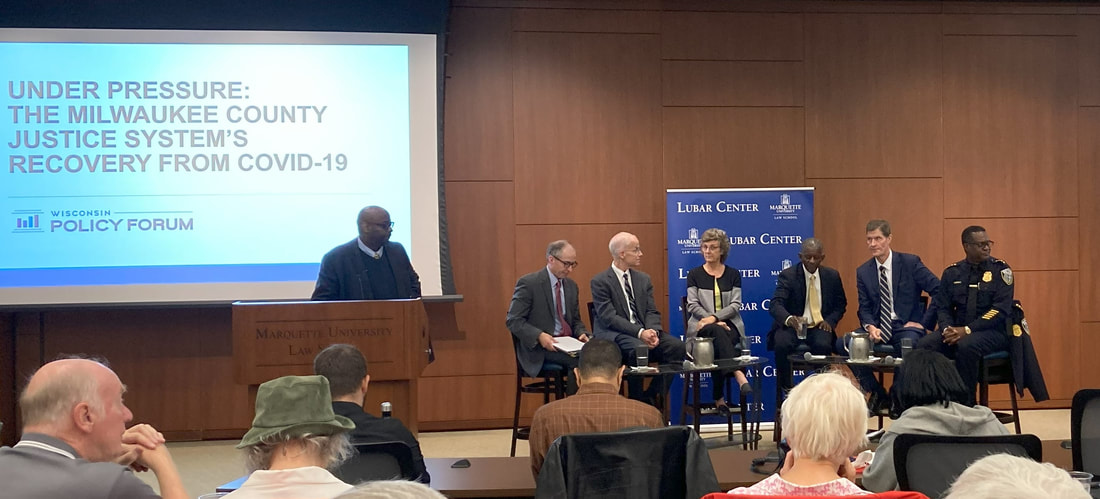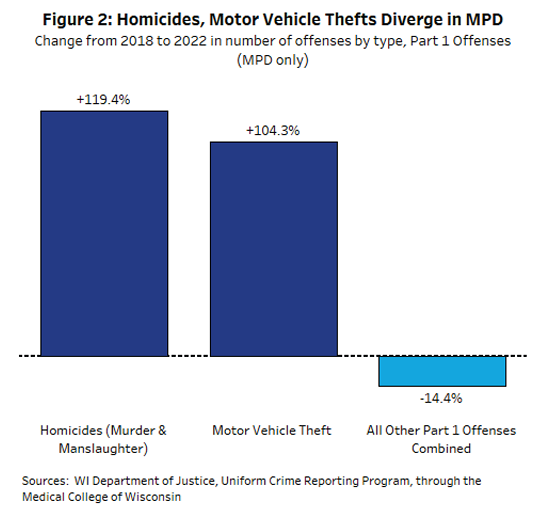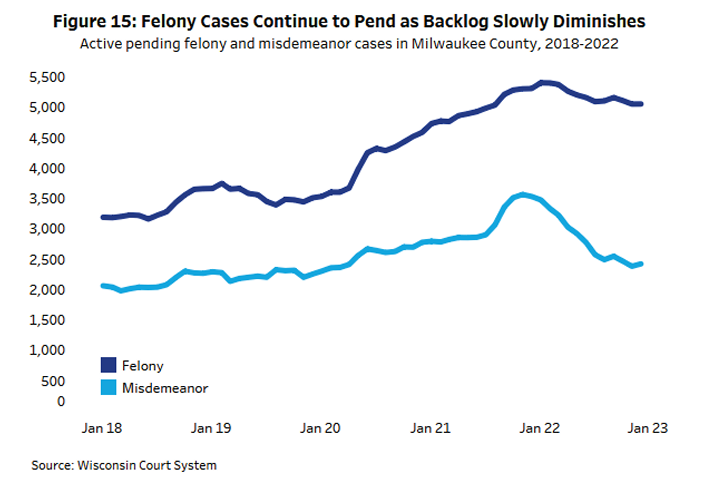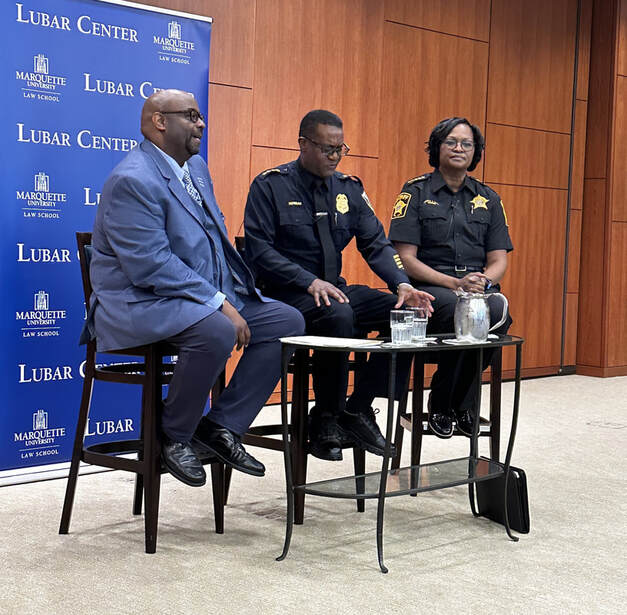|
By Alexandria Staubach
Today the Milwaukee Common Council voted to effectively suspend during the Republican National Convention local requirements that typically govern private security personnel. A substitute ordinance “deems security personnel who hold a private security permit or license, a private detective permit or license, or a reasonably similar credential issued by any United States state, territory, or municipality as in compliance with the provisions of the Milwaukee Security Personnel License ordinance.” The substitute ordinance modifies requirements that have been on the books only since March 2024, when the Common Council voted to require security personnel to obtain a license and execute a bond agreement. Under the March rules, to obtain a license an applicant must not:
Private security firms have proliferated in the United States recently. There are “roughly twice as many security guards employed in the U.S. than there were 20 years ago,” according to an investigation by TIME. In 2021, Allied Universal, an international security company, was the third largest employer in the United States behind Walmart and Amazon. The industry is largely unregulated. Variation from state to state is near limitless. No national body governs private security, and 21 states have no training requirements for private security personnel who are unarmed, says a 2021 report from the National Association of Security Companies. In Wisconsin, unarmed private security personnel are not required to complete a mandated number of training hours, while armed private security personnel are required to complete 36 hours of training. Meanwhile, the District of Columbia requires 98 hours of training for armed private security personnel, New Hampshire requires 4 hours, and Kansas requires none. Per today's new temporary ordinance in Milwaukee, accepting “reasonably similar credentials” from any state or any municipality is necessary because “convention organizers estimate that as many as 1,000 private security personnel may be present,” and if each were required to be locally licensed, the volume of applications would “hamper the License Division’s ability to perform its regular business.” The new ordinance does not identify how credentials will be verified for out-of-state private security personnel or what “reasonably similar” means. The substitute ordinance will be in effect from July 13-20 “or as further required for the completion of the Republican National Committee’s presidential nominating process.”
0 Comments
By Alexandria Staubach
The Milwaukee Police Department on Monday amended Standard Operating Procedure 660 governing police pursuits. The change narrows the conditions for officers to pursue a suspected “mobile drug dealer,” meaning a drug dealer operating out of a vehicle. The policy previously permitted pursuit whenever “occupant(s) of the vehicle are engaged in drug dealing proximate in time to the initiation of the vehicle pursuit.” Under the new version, pursuit is “limited to only incidents in which the observed drug dealing is directly related to a substantive drug investigation or long term investigation,” and then only when a suspect “flees while driving in a reckless manner” and after an attempted stop or a refusal to stop. Review of SOP 660 comes in response to the second-longest pursuit in 2023, which extended 49.9 miles, lasted 55 minutes, and resulted in recovery of a small quantity of narcotics, said MPD Assistant Chief Craig Sarnow during testimony before the Milwaukee Common Council’s Public Safety and Health Committee last week. “We continuously look at this to hone in because there is a risk to the community every time we engage in a pursuit” and “we have seen very tragic endings,” said MPD Chief of Staff Heather Hough at last week’s hearing. In 2010, following four incidents in which third parties were injured, MPD adopted “one of the most restrictive policies in the nation,” which “essentially handcuffed” MPD, said Sarnow. In 2017, at the direction of the Fire and Police Commission, the policy was relaxed to its current state following an uptick in reckless driving, Sarnow said. The 2017 changes “took the hand cuffs off,” and “pursuits have gone up significantly,” he said. MPD statistics show that 14% of all vehicle pursuits in 2023 resulted in crashes, up 30% from 2022. Hearing such policy updates is new for the council's committee and follows the Legislature’s adoption of Act 12 last summer. The act largely stripped the Fire and Police Commission of authority to set policies for the police and fire departments, transferring that power to each department’s chief. The Common Council has taken the position that it retains oversight authority and can veto policy by a two-thirds vote, although that position is under review by the city attorney’s office. “We’re the only game left,” said Public Safety and Health Committee Chair Ald. Scott Spiker. When questioning the change to SOP 660, Spiker seemed at odds with MPD. “Hands will be tied now in a way that they weren’t before,” said Spiker. “Has the world changed enough since (2017) that we should now make a different judgment?” he asked. “What we’re talking about is what officers may do,” said Leon Todd, executive director of the Fire and Police Commission, at the committee hearing. “It doesn’t mean they always can, always will, or always should.” The commission also considered the change to SOP 660 and was unanimous in finding it “reasonable and positive,” said Todd. According to MPD statistics, vehicle pursuits occur most frequently between 7:00 p.m. and 9:59 p.m. on Mondays, Tuesdays, and Wednesdays. Densely populated MPD District 1, which encompasses a five-square-mile area of downtown and the East Side, saw an 83% increase in pursuits from 2022 to 2023. But District 6, on the far southside of Milwaukee, saw a 72% decrease in pursuits from 2022 to 2023. Most pursuits in 2023 occurred in District 7 on the northwest side of Milwaukee (262 pursuits, up 19% from 2022); District 2 on the near southside (253 pursuits, up 25%); and District 3 on the west side of Milwaukee (246 pursuits, up 54%). By Margo Kirchner Milwaukee County’s criminal justice system has not fully recovered from pandemic pressures, and some data results from a recent study of the county’s justice system are not easily explained, say a researcher and five local justice-system leaders. The pandemic showed how the county’s criminal justice system is an ecosystem, with changes in one area impacting other areas, several said. However, the leaders of multiple sectors of the county’s criminal justice system continue to work together to get the system back to its pre-pandemic functioning, or better, they said. Milwaukee Police Department Chief Jeffrey Norman; District Attorney John Chisholm; Tom Reed of the State Public Defender’s Office; and the current and former chief judges of Milwaukee County Circuit Court, Carl Ashley and Mary Triggiano, spoke at a Marquette University Law School Lubar Center event last week. They were joined by Wisconsin Policy Forum President Rob Henken. The speakers discussed an August 2023 Wisconsin Policy Forum report analyzing data from 2018 through 2022. The talk was moderated by Lubar Center Director Derek Mosley. Henken started with discussion of his report “Under Pressure: The Milwaukee County Justice System’s Recovery from COVID-19,” highlighting the following quantitative findings:
Henken said the causes of these results could not be pinpointed. However, his research suggested that total offenses may have increased because police were addressing during the pandemic mainly priority calls rather than conducting proactive policing activities. In addition, the number of MPD sworn officers decreased 17% (more than 300 officers) from 2018 through 2022, which may have caused the decrease in arrests, he said. Staffing declines at the district attorney’s office may have resulted in fewer charges, he said. Henken suggested that the system’s recovery from the pandemic is now impeded by workforce challenges. Norman agreed that there is “still a lot we don’t know on why we’re where we’re at.” As explanation for some of the policing data results, such as the reduced arrest numbers, he pointed to problems during the pandemic with insufficient housing for arrestees, which meant that those accused of violent felonies were held while others were released. He also noted the shifting priorities and measures from the administrations of his predecessors. While one prior chief focused on quantitative measurements of policing such as the numbers of arrests, subsequent chiefs transitioned to qualitative measurements. “Policing is an always evolving activity,” he said. Chisholm noted how the criminal justice became a funnel for societal problems — and how that funnel has been overflowing. What is happening in the community affects what is happening in the criminal justice system, too; things are connected, he said. As an example, shutting down schools during the pandemic may have related to young people stealing cars; shutting down resources for victims of domestic violence may have led to more domestic violence issues, he said. He noted that he would like to get back to “the crappy place we were in 2019,” but said there is no finger pointing between the speakers about problems such as high homicide rates — “we all share this.” Reed said the pandemic caused a problematic reduction in the number of SPD attorneys and private bar attorneys willing to take cases when the SPD has a conflict or heavy workload. Court proceedings were put on hold until an attorney could be appointed, frustrating clients, he said. Reed said that 85% of people charged with crimes qualify for appointed counsel due to poverty. Before the pandemic, the ages of SPD attorneys and private-bar defense attorneys “skewed older,” and when the pandemic hit many older attorneys chose to retire, Reed said. One reason for retirement early in the pandemic may have been that before vaccines, older attorneys were reluctant to visit clients in jails and prisons, where COVID-19 was spreading easily. The Legislature’s increase in SPD pay stabilized his staff, and the increased private bar rate (both are features of the recent state budget) helps, Reed said. His office is down to about 100 cases needing attorneys. Former Milwaukee County Chief Judge Triggiano described the leadership group she pulled together even before the nationwide COVID-19 closures in early 2020. The court initially kept employees and litigants at home but worked around the clock to bring jury trials back while keeping participants safe. Jury trials resumed in the summer of 2020. Current Milwaukee County Chief Judge Carl Ashley, who was part of that leadership group, said Triggiano’s inclusion of system representatives such as those from the DA’s office and SPD may have been unusual, but the group discussed what the system participants could do differently to handle pandemic concerns. Ashley is continuing such meetings to keep discussing how the court and system participants can operate differently to improve. He is proud of the relationships he has with the other system partners. The court has about 5,000 pending felony cases, 1,500 of which are backlog, he said. Ashley noted that “we are not going to prison our way out” of safety issues. When asked by Mosley what he needed for the MPD going forward, Norman said “more trust, from everyone,” but he acknowledged that his department needed to earn that trust. When asked by an audience member whether the elimination of the city residency requirement for MPD officers reduced that trust, Norman said that when an officer responds it should not matter where that officer lives. His officers are expected to provide their services and if they fail to, or do it with disrespect, city residents should report it to the department, he said. Reed said that he would like more honor and acknowledgment of the work by the people at the MPD, DA’s office, SPD, and court who perform their work as a calling. Even when mistakes are made, people should “know that it’s still a noble profession.” The Wisconsin Policy Forum report found that a 2021 spike in serious offenses appeared driven by motor vehicle thefts. And while homicides and motor vehicle thefts in the City of Milwaukee increased significantly between 2018 and 2022, all other serious offenses (such as larceny theft, burglary, robbery, and rape) combined dropped. Homicides in the City of Milwaukee increased from 100 in 2018 to 214 in 2022. Motor vehicle thefts in the city spiked from 4,528 in 2020 to 12,344 in 2021, then declined to 9,447 in 2022, though correction of an MPD technical error in reporting may reduce those numbers slightly, according to the report. The report also described the continuing backlog of felony cases. In March 2023 the number of felony cases in Milwaukee County Circuit Court stood at 5,032, compared with 3,512 cases at the end of December 2019. The number of pending felony cases peaked in January 2022 at 5,405. For a year or two prior to the pandemic, the median age of a felony case in the court ranged between 150 to 200 days. The median age peaked in August 2022 at 331 and at the end of December 2022 was still high at 289 days, according to the report. By Alexandria Staubach
Milwaukee Police Department Chief Jeffrey Norman and Milwaukee County Sheriff Denita Ball identified trust and staffing as the top issues facing their respective departments. They stressed trust, community partnership, and internal department communication as keys to dampen any expected summer crime spike. Norman and Ball discussed their departments’ challenges and their summer crime-prevention strategies at Marquette Law School on Thursday. Marquette Law School Lubar Center Director Derek Mosley facilitated the talk. Norman acknowledged public mistrust of the MPD. He then delivered a passionate sermon about his department’s evolution and asked audience members to “trust that we are doing the right things at the right time for you all.” Norman said he hoped that the community would meet MPD halfway. Both Ball and Norman cited staffing as critical issues in their departments. Ball said it was her No. 1 issue. An inability to attract and retain correction officers means deputies are pulled off the street to keep the Milwaukee County Jail staffed, Ball said. Norman and Ball addressed security at summer events and said both agencies will use a combination of uniformed and plainclothes officers to identify and prevent crime at festivals, in addition to traffic barricades as proactive measures. Norman said that at many summer events in Milwaukee, his officers will seek to be a “backdrop” instead of a “frontdrop.” Both stressed that reactive law enforcement is information based, encouraging the community to say something if they see something. Norman highlighted that the community’s lack of trust in MPD plays a role in the department’s ability to be reactive. On the city’s reckless driving problem, Ball said her department is working collaboratively with suburban police and state patrol officers to identify “high tide” zones and beef up law enforcement presence and intervention at peak times and areas. Norman and Ball stressed that crime in Milwaukee is a community problem that will be solved only in tandem with citizens, community partners, the judicial branch, and the Legislature. The audience challenged Norman and Ball with comments and criticisms about mental health arrests. Norman and Ball stressed that law enforcement alone will not be the answer. On mental health arrests, Norman said that law enforcement in Milwaukee has a mandate to “stay in their lane,” and community partners in the mental health space are essential to answering the city’s crime problem. He highlighted community partners in the room doing that work, including JusticePoint, whose municipal court contract with the city of Milwaukee was recently terminated. Norman further emphasized the many task units now active in Milwaukee, including MPD’s Homeless Outreach Team (HOT) and Crisis Intervention Team (CIT). While these task forces are not unique to Milwaukee, they are not yet common in cities and towns across Wisconsin. Norman said his department was “ahead of the curve with specialty groups to handle these challenges.” Both he and Ball said that the training required to implement these programs needs to be received by the right people and it, too, factors in hiring. Norman expressed willingness to explore further collaboration but hesitated to say that Milwaukee is prepared for officers to stop responding to mental health crises and for his department to do only “sworn work.” Several audience members expressed concern about the prevalence of guns and gun violence. Norman highlighted collaboration with firearm retailers to prevent purchases by those with felony convictions and identify straw man purchases. Norman also highlighted a recent campaign calling on citizens to lock up firearms and remove them from vehicles, which could then be stolen. Ultimately Ball stressed that law enforcement walks a fine line between keeping guns off the streets and respecting citizens’ rights. Both agreed that further restricting firearm possession and distribution was principally a legislative issue. Recent Marquette Law School polls reflect voters’ contradictory positions on safety and crime.
Although 77% of respondents report feeling personally safe from crime when going about their daily activities, an even larger percentage of respondents nevertheless cite crime as a top concern and want increased police funding. In the latest poll results, a whopping 85% of respondents are either “very concerned” or “somewhat concerned” about crime. Indeed, 57% of respondents said they are “very concerned” about crime. Only 14% reported little or no concern about crime. Among those polled, crime ranks third overall among nine issues of concern, behind inflation and public schools. With respondents sorted by political affiliation, 79% of Republicans and 55% of independents are very concerned about crime, but only 37% of Democrats are very concerned about crime. Increased police funding is favored by a majority of respondents regardless of political affiliation. Overall, 78% of all respondents favor increasing state funding for police. By political affiliation, 95% of Republicans, 80% of independents, and 58% of Democrats favor increased police funding. Charles Franklin, director of the Marquette Law School Poll, announced the latest results at a presentation at the law school on Wednesday. The poll measured opinions of 802 registered Wisconsin voters and was conducted between Oct. 24 and Nov. 1. A prior recent Marquette Law School poll, released on Oct. 12, measured opinions on safety. When respondents were asked whether they felt safe from crime when going about their daily activities or whether they were worried about safety, 71% of Republicans, 76% of Independents, and 86% of Democrats responded that they felt safe. Paru Shah, a political science professor at the University of Wisconsin-Milwaukee, explains the conflicting data on personal safety versus concern about crime. The significant concern about crime as an issue likely stems not from one’s own sense of safety but from political messaging of who is hard or soft on crime and how one affiliates with political parties, Shah said in an interview with the Wisconsin Justice Initiative. Those who identify with political talk about being hard on crime will more likely identify crime as an issue to be addressed when asked, she indicated. It’s not about “the actual ‘what’s happening in your neighborhood,’” but rather the messages that people hear about crime happening, she said. “Crime” can also be coded language for Milwaukee, Shah said. Even someone who does not live in Milwaukee can consider crime to be a problem if Milwaukee is seen as a drain on resources. “People in Wisconsin probably do feel pretty safe,” but the narrative of a “big city that is kind of scary, is out there,” she said. “Issues matter, but partisanship is the lens in which we look at those issues,” Shah said. As noted by both Franklin when presenting the latest poll results and Shah after she looked at the numbers, the top three issues cited by Republicans do not overlap with those cited by Democrats. Republicans cite accurate vote counts, inflation, and crime as their top three issues, while Democrats cite abortion policy, gun violence, and public schools. Four of those issues — accurate vote counts, crime, abortion policy, and gun violence — may be seen as related to the justice system and recent cases in the courts. On Aug. 2, four Democrat candidates running for the Milwaukee County sheriff position joined WJI in a virtual forum to answer questions about their professional experience, issues in the sheriff's department, and plans for the office if elected. Candidates (alphabetically) Denita Ball, Brian Barkow, and Thomas Beal appear on the ballot. Mohamed Awad is conducting a write-in campaign. Voters will choose between the candidates in the primary election on Aug. 9. Because no Republican is running, the winner of the primary is expected to win in November as well. If you missed the Salon, or if you want to watch or listen again, click on the image below to view the recording. (Note: Candidate Awad appears in the video without a visual of his person. He did appear visually on screen in the Zoom meeting. However, because of audio difficulties he had to dial in to be heard, so a truncated phone number appears in the video while he is speaking.) Recordings of this and several past Salons are also available on WJI's YouTube channel here.  Johnson Johnson By Gretchen Schuldt The Wisconsin Justice Initiative on Tuesday called for Milwaukee officials to develop and adopt enforcement guidelines and accountability measures for the recently announced stepped-up use of the city's curfew ordinance against juveniles and their parents. "We have seen in the past valid concerns raised about police practices by the ACLU’s stop-and-frisk lawsuit," WJI President Craig Johnson said in a letter to Mayor Cavalier Johnson, Police Chief Jeffrey B. Norman and the Common Council. "Any policy that increases the number of police-citizen encounters and places too much reliance on police discretion raises concerns that these practices will again prove problematic to certain groups." The ACLU suit resulted in the Milwaukee Police Department and the city agreeing to reforms in pedestrian and vehicle stop and search procedures. The ACLU presented strong evidence of racial disparities in who was stopped and searched. Mayor Johnson and Chief Norman announced the increased curfew enforcement last week, in the wake of the mass shooting near the Deer District after a Bucks' game. No juveniles have been arrested in connection with the shooting, and Norman said the stronger curfew enforcement was meant to protect them. WJI's Johnson said the move could worsen police-community relations unless "the city adopts and publishes accountability measures and enforcement guidelines." "Curfew enforcement guidelines should make clear how police will enforce the curfew and who is at risk of receiving citations," Craig Johnson wrote. "Is a 16-year-old making their way home from a Brewers’ game going to get a ticket? How about a youth waiting at a bus stop after work?" The city's primary curfew ordinance makes it illegal for anyone 16 or under to "congregate, loiter, wander, stroll, stand or play in or upon the public streets, highways, roads, alleys, parks, public buildings, places of amusement and entertainment, places of employment, vacant lots or any public places in the city either on foot or in or upon any conveyance being driven or parked thereon." Violations can bring forfeitures of $100-$200. Parents and guardians can be cited if they "suffer or permit or by inefficient control to allow" violations by minors. There are exceptions to the prohibitions. A youth can be out and about while with a parent or guardian or when "exercising first amendment rights protected by the United States constitution or the Wisconsin constitution, including freedom of speech, the free exercise of religion, and the right of assembly," according to the ordinance. A parent or guardian will not be held liable for any violation if they have filed with the police a missing persons report regarding the youth.
"How will an officer determine whether a young person qualifies for one of the exemptions in the ordinance?" Craig Johnson asked, adding, "What are the standards for deciding what parents are cited and when?" Craig Johnson cited the city's "contributing to truancy" ordinance as an "object lesson in the need for enforcement standards." In 1995, when lobbying for such an ordinance, then-Police Chief Philip Arreola said he was concerned about adults and businesses who "were responsible for contributing to the students (sic) absence from school by hosting parties and/or allowing students to congregate/loiter on their premises.” The contributing to truancy ordinance, since then, however, has been used mostly against Black women, Johnson said. "From 2015 through September 2020, according to Municipal Court statistics, 94% of contributing-to- delinquency citations were issued to women, 62% to Black people, 25% to Hispanic people, and 11% to Whites," he wrote. "That disproportionate caseload suggests inequitable enforcement." "How will MPD ensure that police equitably enforce the curfew ordinances?" he asked. "Is MPD willing to publicly report the demographics and ages of those cited?" He also asked whether businesses would be subject to curfew ordinances that apply specifically to them. One ordinance, for example, requires venues with a public entertainment license to announce an approaching curfew 20 minutes before it takes effect. "All entertainment shall cease for the 20-minute period prior to curfew," the ordinance says. Violations carry forfeitures of $500 to $2,000. It also is generally illegal for a business to allow anyone under 17 to enter or stay on the premises after curfew, and hotels, motels, and rooming houses are prohibited from allowing anyone under 18 to "visit, loiter, idle, wander or stroll in any portion of such" business from 10 p.m. to 7 a.m. Violations of that ordinance carries forfeitures of $100 to $200.  Ald. Michael Murphy Ald. Michael Murphy 'By Gretchen Schuldt A proposed Milwaukee ordinance that would label some repeated traffic offenses a public nuisance was sent back to committee by the Common Council Tuesday after the city attorney's office said it was too broad and unenforceable. "The ordinance would apply to a single violation of one of the listed traffic laws; and the listed traffic laws include both serious and relatively minor violations," Deputy City Attorney Todd Farris wrote in a memo. "For example, one violation for 'driving too slow' would, under the proposed ordinance, be a nuisance per se." "We believe that in an injunction proceeding brought by the City, a court would likely conclude that the proposed ordinance is unreasonably broad....In other words, we do not believe that the proposed ordinance would accomplish the goal of making it easier for the City to obtain injunctive relief against problem drivers," he wrote. Ald. Michael Murphy, the main sponsor of the measure, introduced it as a way to deal with the endemic reckless driving that is infuriating residents and threatening lives and limbs. Under the proposal, numerous driving offenses related to reckless driving, such as speeding, fleeing an officer, running stoplights, or driving on sidewalks, could be considered a public nuisance, allowing the city to file suit to seize the car involved. Murphy has said the ordinance was meant to target people stopped multiple times, Some statutes included, however, go beyond reckless driving. One offense covered by the ordinance, for example, would be leaving a leaflet on a car. In a memo provided by his office last week, the Milwaukee Police Department said the driving-related state laws included in the ordinance "were intended to broadly cover sections that refer to behavior that falls within the spirit of reckless driving, since not all reckless driving violations are cited under that specific statute. For example, driving on the wrong side of the road is perceived as "reckless' and could be cited under reckless driving... Not all subsections within those statutes may directly apply. They are broadly defined to buttress a nuisance litigation action under a nuisance per se theory." The city attorney's opinion, also signed by City Attorney Tearman Spencer, suggested that "an ordinance declaring habitual or repeated violations of the more serious traffic laws to be a nuisance per se would stand a much better chance of being upheld by a court in an injunction proceeding." By Gretchen Schuldt
Waupaca County District Attorney Veronica Isherwood, in an extraordinary letter to defense lawyers, said Waupaca County Sheriff Tim Wilz acknowledged that his department regularly alters reports to remove information that could help defendants establish their innocence. "Additionally we have received information that reports to my office of these irregularities are discouraged," she wrote. Wilz admitted the practice of altering reports in testimony, Isherwood said, but she did not give specifics. "It was also disclosed that evidence of any changes were not preserved," she said in a letter addressed to county defense attorneys and dated Friday. "We have no idea if the reports in the case you are defending were changed or altered in any way." The state, Isherwood said, has evidence that in one case, "Waupaca County Sheriff Captain Julie Thobaben altered a report authored by a deputy which resulted in the removal of exculpatory information. Captain Thobaben testified to her actions this week." That is the only instance "where we are certain a report was changed, but the sworn testimony that this happens regularly is very concerning," Isherwood said. Under the legal doctrine called the "Brady rule," prosecutors must disclose evidence that is exculpatory or helpful to the defense. "Under normal circumstances you would receive notification of a Brady violation, only when an affected officer was subpoenaed to testify," Isherwood said. "The attorneys at the Waupaca County District Attorney('s) office believe under this circumstance, the spirit of Brady/Giglio makes it incumbent upon us to notify you of this irregularity." "We pride ourselves on upholding an extremely high ethical standard in our charging decisions and prosecution of criminal cases," Isherwood said. "The loss of someone’s liberty is a tremendous responsibility that we do not take lightly. The Courts have been notified of this information," she said. Third of three stories. Marijuana was the second most-common target in residential drug searches conducted by police in Milwaukee County in 2019, well behind cocaine but ahead of heroin, a review of search warrant filings found. Trailing far behind and seldom searched for were meth, opiate painkillers, and Ecstasy, according to an analysis by Marquette University journalists. Rarely was marijuana – which Milwaukee County and many municipalities have taken steps to decriminalize – the sole drug targeted by police in a particular raid. That was the case in just 11 of 433 drug search warrants carried out at Milwaukee County addresses in 2019. That year was chosen for the review because it was the most recent year unaffected by the COVID pandemic, which affected law enforcement and court operations. But marijuana was in the search mix in 54% of warrant requests, most of them by Milwaukee police and multi-agency drug task forces. Here’s the breakdown of how often police targeted each drug in the 433 searches:
Police reported nabbing 26 pounds of pot on a summer day in 2019 at a home on Milwaukee’s northwest side, but court records show no charges against the suspect until a separate incident in 2021.
In south suburban Greenfield, police investigated alleged gang members and made multiple arrests on marijuana, heroin and cocaine charges with help from a home search following neighborhood complaints in 2019. No matter the drug, searches of residences were pretty effective in finding potentially incriminating evidence. Police found drugs in at least two out of every three residential searches (67%). (Excludes canine drug sniffs outside homes.) Sloppy or inconsistent reporting by police on public search warrant documents makes that statistic a little squishy. The actual number is likely higher. Sometimes police report finding evidence but don’t attach the inventory or otherwise specify results. The “success” rate in finding evidence rises to 81% when including things such as weapons, drug paraphernalia, ammunition, and business records of dealing. (Again excluding the sniffs.) Nearly every canine “odor search” included pot as a target in 2019, the review found. That might be changing for some police departments as marijuana legalization spreads in the U.S. – though not yet in Wisconsin. “Many jurisdictions that are buying drug dogs now are not having those drug dogs trained to detect marijuana, in anticipation of potential legalization in this state,” said South Milwaukee Police Chief William Jessup. “If you have a dog that's trained to detect marijuana, you can't untrain that dog,” he added. Jessup said South Milwaukee police are moving away from doing odor searches for marijuana. What is the track record of “Bravo” and “Rex” and all those other drug-sniffing dogs that local police have reported using outside residences to build a case for doing a search of a residence? The Marquette review found that in odor searches, police report the dog almost unfailingly found the presence of drugs. Police used positive dog hits to beef up their applications for far more intrusive search warrants. But the accuracy of police dogs has been questioned, and studies have shown that there are a significant number of false alerts – enough to raise questions about the usefulness of any single drug sniff. The Marquette review found less interest in marijuana searches by anti-drug task forces that go after higher-level drug traffickers and employ officers from multiple agencies – local, state and federal. The individual municipal police departments that conducted searches – and not all of them did – showed more interest in searching for pot. |
Donate
Help WJI advocate for justice in Wisconsin
|
Copyright © 2024 Wisconsin Justice Initiative Inc.
The Wisconsin Justice Initiative Inc. does not endorse candidates for political office. The Wisconsin Justice Initiative Inc. is a 501(c)3 organization.
The Wisconsin Justice Initiative Inc. does not endorse candidates for political office. The Wisconsin Justice Initiative Inc. is a 501(c)3 organization.








 RSS Feed
RSS Feed